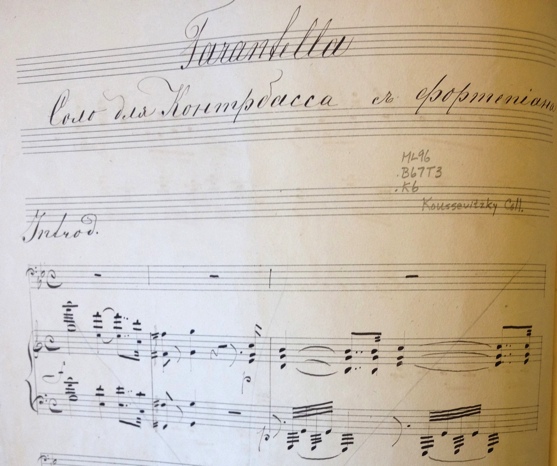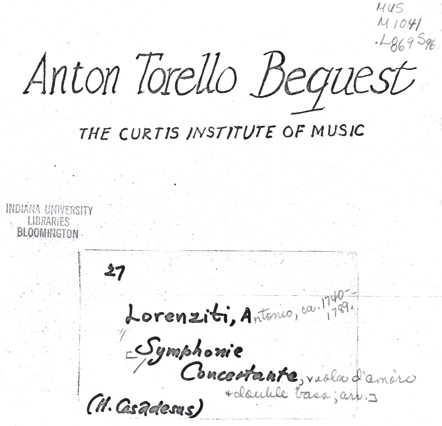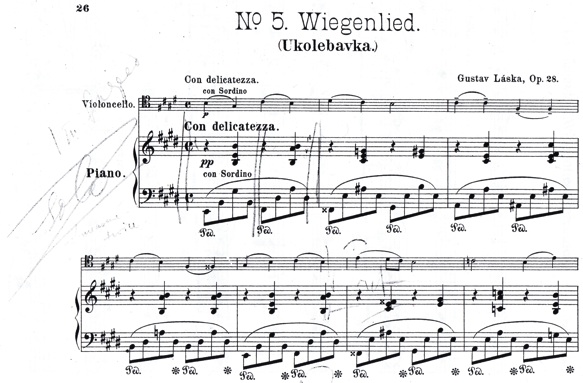| |
Volume 9, September 2017
Koussevitzky's Double Bass Repertoire: A Reassessment
by Andrew Kohn, Ph.D.
4. Koussevitzky performed extant solo bass music, including concerti.
• Giovanni Bottesini, Grand Duo Concertante. Although we have no clear record of a public performance, Arthur Abell, in previewing Koussevitzky's New York recital of 1928, recalled hearing this piece played privately by Koussevitzky, violinist Jacques Thibaud and, at the piano, Fritz Kreisler.20 This is corroborated, or at least echoed, by an unpublished document that survives in the Library of Congress, referencing "the duet for voilin [sic] and double bass y [sic] Bottesini."21 This anonymous Chapter 9, comprising pp. 116-31, records Koussevitzky addressing the author as "Arthur" — probably also by Abell, then, and probably from his unpublished memoirs.22
• Bottesini, Tarentella. One of the most popular of Bottesini's works for bass and piano, Koussevitzky's hand-written performance material for this piece is in BPL (Figure 3). He performed the piece in his early career in Russia, at his Berlin debut in 1903, and frequently thereafter.
Figure 3: Koussevitzky's copy of Bottesini, "Tarentella," opening (BPL)
• Bottesini, Fantasia "la Sonnambula." Arguably the best of Bottesini's seven pot-pourris, Koussevitzky first performed this piece in Berlin in 1907 and repeated it elsewhere afterwards. His performance material has not survived.
• Henri Casadesus ("Lorenziti"), Sinfonia Concertante. As he did so often, Casadesus ascribed this composition to another composer from an earlier era: in this case, a certain Lorenziti — citations sometimes name Antonio [Joseph Antoine, c1740-89], sometimes his brother, Bernardo [Bernard, after 1749-after 1815]. Koussevitzky's solo parts in C and D (that is, for both the orchestral tuning of G, D, A, E and the common solo scordatura of A, E, B, F-sharp) are in BPL and reproduced in Stiles, Compositions, 144-60. Citations of early performances include Astrov, who cites a performance in the home and presence of Tolstoy in 1910, and Stoll, who cites the performance with the Berlin Philharmonic under Arthur Nikisch in 1911.23 The piece was brand new, since the online catalog of the Bibliothèque nationale de France gives the work a date of 1910; a review cites a performance of the cadenza alone as early as 1909.24 Koussevitzky later performed the work with Casadesus in Paris in 1921 and (perhaps) 1923, as well as in the Boston recital of 1928. A hand-written copy of the piano score, (Figure 4), which makes it crystal clear that "Lorenziti" is actually Casadesus, is preserved in Anton Torello's papers in the library of the Curtis Institute (with a Xerox copy at Indiana University). Casadesus' manuscripts, including this piece, are in the Bibliothèque Nationale in Paris.
Torello is a major figure in American double bass history, having served both as principal bassist of the Philadelphia Orchestra and as the first professor of double bass at the Curtis Institute. He performed the work, along with concertmaster Thaddeus Rich and the Philadelphia Orchestra, conducted by Leopold Stokowski, on Feb. 27 and 28, 1920. A modern performance was given at the 1998 convention of the international viola d'amore society; another was given by the Wandsbeker Symphonie Orchester in 1999; another, with piano reduction, is available via YouTube, performed by the duo "Sweet 17."25
Figure 4: Casadesus, cover from Symphonie Concertante, attr. Lorenziti, with piano reduction by Torello (from copy at Indiana University)
• Gustav Láska, Berceuse. Czech double bassist Gustav Láska (1847-1928) composed a set of five pieces, op. 28, for bass and piano: "Idylle," Ländler," "Fantasie Impromptu," "Masurek," and "Ukolébavka." The fifth is Koussevitzky's piece, variously translated as "Berceuse," "Cradle Song," and "Wiegenlied." This should not be confused with Láska's additional piece without opus number for bass and piano, "Schlummerlied." As an additional complication, Láska arranged another "Wiegenlied," composed by Michael Hauser, for bass with quartet accompaniment, op. 11, no. 2.26 Koussevitzky's personal copy is in BPL, an edition of 1892 by Breitkopf & Härtel, (Figure 5). The other movements have no markings, suggesting that they were never performed. It is an odd quirk that Koussevitzky's personal copy is not of the original version for bass and piano, but rather the transcription for cello and piano.
Figure 5: Koussevitzky's copy of Láska, "Wiegenlied," opening (BPL)
• Franz Simandl, Concerto. Astrov (20) cites a performance of this piece on June 22, 1899. According to a review in Musical Courier, Koussevitzky also included this work in his second Berlin recital of 1907 (as noted, he often remained in a city long enough to perform two different recital programs).27 It is a weak piece, rather like a pot-pourri of Simandl's famous etudes. It is unlikely that the citation is a garbled reference to Simandl's transcription of the Handel Oboe Concerto in G minor (discussed below), since the recital programs provided sparing information and excluded such information as editors and transcribers. In any event, the Simandl Concerto did not remain a part of Koussevitzky's performing repertoire. No performance material has survived.
• Eduard Stein, Concertstück. This work was published under the aegis of Franz Simandl, but separately from his famous and influential series, the Hohe Schule (discussed below). Now rarely performed, the piece was very important in Koussevitzky's career. With this work, in 1894, Koussevitzky won a position in the Mariinsky Theater — a position he declined — as well as the position he held for the next decade in the Bolshoi Theater. Koussevitzky's later performances of the piece are repeatedly documented in Musical Courier, including in Leipzig, Vienna, Paris, and Berlin, demonstrating the importance of this repertoire item in his early career. The original publication is now quite rare, but a reprint, on smaller paper and with light editing by Frederick Zimmermann, is widely available, published by International Music Company (1957). Despite the dates added to this reprint — that is, "(1701-1775)" — the composer is the Eduard Stein who lived from 1818 to 1864, who studied with Weinlig and Mendelssohn in Leipzig, and who directed the "Loh Concerts" in Schwarzburg-Sondershausen beginning in 1853; the Concertstück was premiered at a Loh Concert on September 17, 1854.28
|
|



